- Botanical Description
- Chemical Composition
- Therapeutic Properties
- Procurement of raw materials
- Methods of application
Perennial herb Hydrastis Canadian is the only member of the genus Hydrastis, which belongs to the family of the Lyutikas. In natural conditions it occurs on the territory of Canada and North America, but in some countries of Western Europe and regions of Russia it is specially cultivated for the purpose of obtaining medicinal raw materials. The root of the plant in fresh form is widely used in homeopathy for the preparation of therapeutic tincture, and in dried one it is used in folk medicine. It is effective for inflammatory diseases of the respiratory tract, oral cavity, eyes, infections in the urinary system, problems in the digestive tract, for stopping bleeding. Among other names of hydrastis, the following are known: Canadian hemp, golden root, yellow-root Canadian, gold seal.
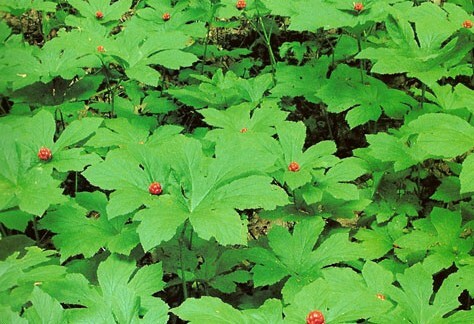
Botanical description
Hydrastis prefers shady forests with high humidity. Reproduction is carried out vegetatively by parts of rhizomes.
Rhizome is powerful, short, fleshy, brown-yellow in color from the outside and golden yellow on the fracture, with deeper traces from dead shoots. Horizontal roots thin not more than 6 cm long.
The stalk of the plant is upright, rounded in cross section, naked at the bottom, covered with hairs in the upper part, reaches a height of 15-30 cm. There are only two leaves on each stalk on short petioles: one largerlocated at the base of the stem, and the other about 2 times smaller - at the top. From the underside of the leaf veins are clearly visible. Also there is a basal leaf, which disappears rather quickly. The leaves are palpately-dissected into 3 to 9 lobes with serrated edges, wide lobes and a heart-shaped base.
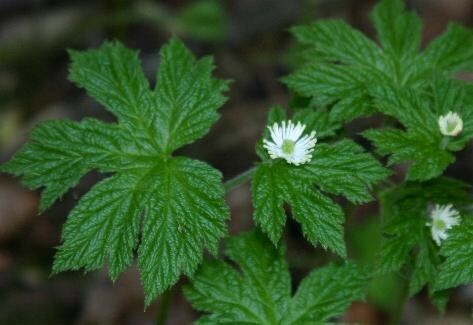
Blossoms hydrastis in May. Flowers of small size, up to 1.8 cm in diameter, bisexual, single, located on the tip of the stem on a short pedicel, have a white or white-green color. Perianth is simple, three-leaved, has the shape of a cup, consists of several leaves, which very quickly fall off. The flower contains from 40 to 75 stamens of white color up to 8 mm long, they are the most visible part of the flower.
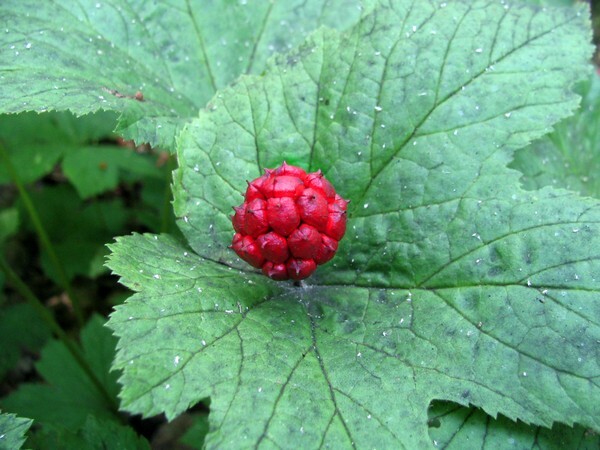
The fruit ripens by July, gradually changing its color from green to bright red. They are fleshy prefabricated drupes, consisting of 8 to 12 fruit-stems. The fruit resembles a raspberry in shape. Each drupe inside contains one or two hard-skinned, glossy ovum-shaped seeds 3 mm in length.
Chemical Composition
For therapeutic purposes only rhizomes and roots of Canadian hydrastis are used. They contain the following compounds:
- alkaloids( canadin, berberine, hydrastine);
- minerals( aluminum, calcium, copper, cobalt, phosphorus, iron, silicon, magnesium);
- vitamins( A, B, E, C, inositol);
- bitterness;
- proteins;
- essential oils;
- starch;
- fats;
- dietary fiber.
Interesting: The yellow color of the roots is due to the presence in their composition of the isoquinoline alkaloid berberine.
The healing properties of
Hydrastis Canadian is used in homeopathy and folk medicine in a fairly wide range of diseases. It has the following effect on the human body:
- dilates blood vessels and lowers arterial pressure;
- increases uterine tone, stimulates labor activity;
- stimulates the immune system;
- enhances the secretion of gastric juice and bile improves digestion;
- has a tonic effect;
- helps to stop profuse and prolonged menstruation;
- exhibits antibacterial properties.
The healing properties of Canadian hydrastis or yellowgrass can be used on its basis for chronic catarrh of the mucous membranes of any organs, especially in rhinitis, sinusitis, bronchitis, sinusitis, pharyngitis, tonsillitis, otitis. They contribute to the liquefaction of mucus and sputum and facilitate the process of its excretion. The vitiligo increases the antiviral effect of lymphocytes and activates the entire immune system, which allows you to prescribe it in ARVI to accelerate recovery. Antibacterial properties make it useful for various infections of the urinary tract.
Indications for the use of hydrastis in homeopathy are various pathologies of the gastrointestinal tract: inflammatory processes, diarrhea, flatulence, jaundice, constipation, pain in the epigastric region, due to impaired liver function, tumor processes, gastric and intestinal bleeding.
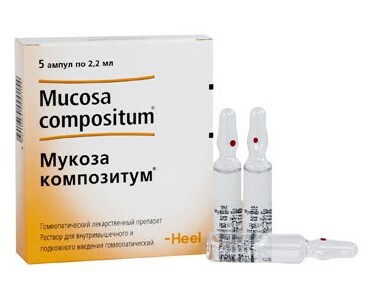
Yellow-root Canadian has found application in gynecological practice in case of severe premenstrual syndrome, menstrual irregularities, uterine bleeding and heavy menstruation. The rise in the tone of the uterus arising on the background of its reception contributes to the narrowing of the blood vessels and the stopping or lowering of the intensity of menstrual bleeding.
A shepherd's bag is similar to the hydrastis mechanism of hemostatic action. It also causes a reduction in the musculature of the uterus, lowers blood pressure and strengthens the intestinal motility, so this plant is able to replace the yellow root with uterine and other bleeding.
Interestingly: Hydrastis Canadian as a remedy for many diseases began to use even Indians in North America. Officially, this plant was introduced into homeopathy in 1866.
Outer hydrastis in the form of infusions of rhizomes is used to remove warts, rinse eyes with trachoma, conjunctiva, blepharitis, keratitis, rinses with stomatitis. It helps with skin diseases accompanied by a rash, varicose ulcers, eczema, psoriasis, reduces edema on the skin after bites of insects and snakes.
Hydra in homeopathy is used alone or as a part of homeopathic remedies. For example, it is part of some Heel products: Colchicum Compositum C, Ubiquinone Compositum, Ovarium Compositum, Agnus Compositum, Mukoza Compositum.
Procurement of raw materials
For medicinal purposes, roots and rhizomes of Canadian yellowcorn are suitable, the age of which is more than 3 years. Their collection and harvesting is carried out in the autumn, after the ripening of the seeds. For homeopathic medicines, fresh roots are used.
The workpiece is produced as follows. The roots are carefully excavated, cleaned of debris and foreign impurities, washed with running water and dried in a well-ventilated room.
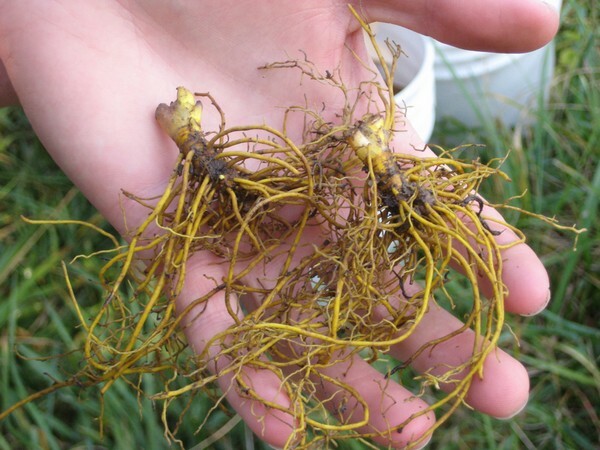
Finished raw materials are curved horizontal rhizomes 3-6 cm in length and 1 cm in diameter, on their surface there are clearly visible round or oval recesses or scars. The smell is weak, but rather unpleasant and peculiar, the taste is bitter.
Ways of using
In folk medicine from the Canadian yellowfin prepare preparations for external and internal use.
Important: Before starting the use of hydrastis for treatment, it is necessary to consult a doctor, especially if the medication is to be taken internally. The main contraindications are allergic reactions, pregnancy and breastfeeding.
Alcoholic tincture
Well-ground roots of the plant in an amount of 10 g pour ½ cup of vodka. Insist two weeks in a darkened place, periodically shaking. At the end of the time, filter and take the tincture as directed:
- with a cold and colitis 10 to 20 drops three times a day;
- with constipation and heavy menstruation 20 drops of tincture are bred in 100 ml of water and taken in the morning and evening after an hour after eating;
- for lubrication of affected skin areas with eczema, rashes, psoriasis and mouth rinses with stomatitis 5 ml of alcohol tincture is mixed with 100 ml of distilled water;
- for syringing for inflammation of female genital organs of infectious nature 2 ml of tincture is bred in 100 ml of boiled water.
Water wax from warts
The roots of hydrastis( 10 g) are poured into a glass of boiling water and boiled for 10 minutes at minimum heat, covered with a lid. Then turn off the gas, allow to cool to room temperature and filter. In the resulting solution, a cotton swab or disc is wetted and applied to the wart many times throughout the day.
Video about digging out hydrastis:
